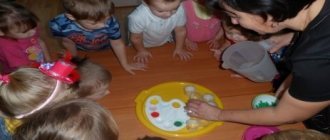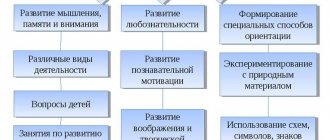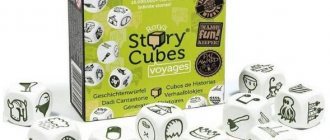Cognitive activities
Materials found: 143 Shown: 1 — 10
Integrated educational activity with children of middle preschool age on the topic “Zayushkina’s hut”
Program content. 1. Clarify knowledge about domestic and wild animals. 2. To form an idea of the meanings and functions of a traffic light. Instill traffic rules. 3. Strengthen the ability to determine the length of objects by...
FGT topic Furniture 2 junior group
“Rainbow” - topic “Furniture” Form ideas on the topic “Furniture” 2-ml. group To form an idea of the concept of “furniture”: • purpose; • Types of furniture; • Furniture parts; • What furniture is made from; • Methods of handling. Table,…
Three periods of autumn (compendium)
Summary of direct educational activities on the topic: “Three periods of autumn.” (preparatory group) Educational area “Cognition”: systematize children’s knowledge about autumn and autumn phenomena, consolidate ideas about...
Integrated lesson for children of senior preschool age using TRIZ “Oh, my bast shoes”
Goal: 1. Continue to develop the need for knowledge of the man-made world. 2. Improve knowledge about everyday objects (their color, shape, size, material, purpose. 3. Develop coherent speech. 4. Exercise in…
Summary of an open lesson with children of the preparatory group. NGO "Cognition", "Communication". on Topic: “The Journey of Water”
Lesson notes for the preparatory group Fr. O. “Cognition” “Communication” on the Topic: “The Journey of Water” Form of teaching: open lesson on cognitive and research activities of children. Number of children: subgroup Purpose:…
Summary of direct educational activities. "Autumn Fair"
Goals: to generate interest in the fair. Objectives: To summarize and systematize ideas about autumn according to the main, essential features, to consolidate knowledge about a person’s autumn preparations for winter in the garden. Activating the dictionary for...
Corrective lesson on the topic Clothes
Correctional lesson on the topic Clothes Goal: To develop the ability to differentiate clothes by season, to practice the use of pronouns, to use plural nouns in the nominative case in speech, to develop...
An educational activity with elements of work activity. “A hut is not red in its corners, but red in its pies”
Cognitive lesson with elements of work activity in the senior group. “A hut is not red in its corners - it is red in its pies” Goal: To introduce children to ancient household items and their purpose. Give children knowledge about what yeast is and...
Cognitive-speech lesson in the second junior group. "What grew in the garden"
Municipal budgetary preschool educational institution, child development center - kindergarten No. 19 “Joy” Cognitive - speech lesson in the second junior group TOPIC: “What grew in the garden” Prepared by: Marina Efimova...
Topic: “Journey to the Homeland of the Tomato”
Lushnikova M. V., teacher of the 2nd qualification category of the MKDOU D/s “Cherry”, Vargashi village.
Topic: “Journey to the homeland of the tomato.” Software tasks. Educational: to give children an idea of the plant’s need for light, ... Pages: ...
All sections
Summary of a lesson on the development of cognitive abilities in children 5 - 7 years old.
Being ready for school today does not mean being able to read, write and count.
Being ready for school means being ready to learn it all.
L. A. Wenger, A. L. Wenger
This lesson is aimed at developing in a preschooler such qualities as attention, memory, thinking, and motor development, which are so necessary for entering school.
Lesson: Development of cognitive abilities in children 5-6 years old.
Topic: Let's help the doll Aisulu.
Program content: Continue to teach children to determine the sequence of events; group objects according to common characteristics; develop attention, memory, thinking, fine motor skills, the ability to work according to the proposed model; develop the ability to work in pairs;
Equipment : demonstration pictures from the series “What’s extra” and “What’s first - what’s next”, cards for individual work “Arrange the icons”, “Find the differences”, “Complete the cells”.
Progress of the lesson:
1.Organizational point:
Hello guys! Let's welcome each other to our lesson.
Hello, golden sun!
Hello, blue sky!
Hello my friends,
I'm very glad to see you!
Guys, today the doll Aisulu came to our lesson. She asks for help to complete some tasks, it is very difficult for her to cope with them, because she does not study at school. Shall we help Aisul? (Children's answers)
2. Main part.
Exercise “Say it in one word.” Guys, we need to help Aisul name objects in one word:
A) Oranges, pears, apples, bananas, tangerines are ... (fruits)
B) Tomato, cucumber, carrot, onion, zucchini are... (vegetables)
B) Spruce, poplar, birch, aspen, oak are... (trees)
D) May, November, December, February, August are... (months)
D) Chanterelle, fly agaric, boletus, russula are... (Mushrooms)
Task “Find the extra object.” You guys are great, Aisulu is pleased with your help. The next task for Aisulu is also very difficult. Let's help her find the extra one among the objects and name it. Children look at the pictures provided, find an extra item, call it: 1) Extra cocktail, because everything else is different types of ice cream; 2) Extra candy, because pie, cheesecake, bagel are baked goods); 3) An extra leaf because the rest are flowers; 4) Extra strawberries, because all the others are mushrooms; 5) There is an extra hedgehog because the rest are pets; 6) An extra cactus, because the rest are African animals; 7) Extra cucumber, and the rest are fruits; 8) There is an extra ball because the rest are vegetables.
How pleased our Aisulu is! And we got ready for the next task.
Exercise "Who is faster." How pleased our Aisulu is! And we got ready for the next task. Take the cards and put icons in the shapes as shown in the example. Let's compete to see who is the fastest. (Children complete the task on cards).
Physical exercise: We clap-clap with our hands, we stomp-stomp with our feet.
We are eyes blink-blink, we are shoulders chick-chick.
One here, two here, turn around.
They sat down and stood up, they sat down and stood up,
Immediately they became Vanka’s stand-up,
And then they started galloping, like our merry ball.
One - two, one - two - the game is over!
Work in pairs “Find the differences”. And now, guys, we will help Aisul find the differences in the pictures. (Children find differences in the pictures).
The game “What comes first, what comes next.” Guys, let's take a close look at the pictures and help Aisul determine what happened first and what happened next.
The task “Complete the drawings in the cells.” Guys, Aisulu has unusual pictures, but they are only half drawn. Let us finish the second half so that the picture is complete. (The guys complete the picture by cells.)
3. Summary of the lesson.
Guys, our lesson is over. You were all great, you all did a great job.
Tell me, did you have any difficulties?
What did you like most about the lesson?
What else would you like to repeat?
Guys, the Aisulu doll was very pleased that you helped her. She has prepared sweet gifts for you.
ATTENTION – ATTENTION
In order for a child to grow up attentive, be able to concentrate and quickly respond to any changes, it is important to train his attention. You can start as early as 4 years of age. At the same time, it is also not necessary to purchase expensive manuals: the suitable “equipment” is always at hand.
For example, you can play these games.
- Variations on the theme “edible - inedible” (sweet - unsweetened, flies - does not fly, clothes - not clothes).
- "What's new?" (on the table, in the picture, in the guise of dad, in mom’s clothes).
- “Find the differences” (in two pictures).
- “Caravan” - the mother names the animal, the child repeats it and adds his own. Mom repeats both and adds a third. You need to repeat in the order in which the animals are named. They play until someone gets lost.
- "What changed?". During a morning walk, mother and child try to remember everything that surrounds them, and in the evening they compare what has changed (someone hung up the laundry, old women sat on a bench, a car drove up to the next door);
- Close your eyes and name as many different sounds as possible in the room (a clock, the noise of a refrigerator, the purring of a cat) or outside the window (cars driving, birds singing, the wind rustling).
- Close your eyes and tell what order is on the shelf, on the table, what mom is wearing.
It is important to start with easier tasks, gradually making them more difficult, and not forgetting to praise your child for success.
READING AND WRITING
Your child will need these skills in school. After all, the first thing he will have to master by first grade is reading and writing.
In the fifth year, you need to plan lessons with your preschooler to prepare your hand for writing. Here you will already need the first teaching aids - children's copybooks. These are excellent “developers” for the hand, helping the child develop the necessary muscles so that the hand does not get tired while writing. In children's copybooks, the child is asked to trace simple patterns point by point and then reproduce them independently.
To reinforce the perception of the first sound in a word (the entire study of letters is based on this), you can glue cards with images of letters to different objects in the house. Let the child determine in which case the card is glued correctly and in which case it is not.
When teaching preschoolers to read, more and more mothers choose Zhukova’s primer. It consistently shows how letters “merge” into syllables and gives important recommendations to parents. In addition, Zhukova’s teaching methods meet the requirements of school curricula.
Advice
Before you start teaching your child to read, teach him to hear all the sounds in words, in different parts of the word (at the beginning, middle, end), and also to isolate syllables in words. You can find many entertaining games for this.
Only with this approach will the child learn to read and write without errors (children often transfer into writing what they hear or perceive incorrectly).
MEMORY IS NOT ONLY VISUAL
A person remembers not only what he sees, but also what he hears or does. Little Man is no exception. Therefore, memory development must be comprehensive and affect all these aspects.
- Visual memory is developed by games for memorizing a drawing or picture with their subsequent description, describing from memory the location of objects in a room, on a shelf, on a table. You can ask the child to remember what he wore for a walk yesterday, what his mother was wearing. Or draw a grid of several cells on paper, place small objects in each, and then, after giving the child time to memorize, turn it away and swap several objects. Let him try to restore the original arrangement.
- Auditory memory is trained by memorizing poems, nursery rhymes, songs, as well as retelling fairy tales or impressions of significant events, and following oral instructions from an adult. For example, buy several items in an impromptu store and not forget anything. Or place items, setting the table, in a certain sequence.
- Motor memory can be trained by all kinds of games in which children repeat the movements of adults in a certain order. Sometimes an adult can “make a mistake,” while the child needs to do everything correctly and not get lost.
Advice
When going to the store or for a walk, plan your route in advance and ask your child to comment on where to go next. This is also auditory memory training.
MUSICALITY, SENSORY, MOVEMENT
One of the main factors in the proper development of a preschooler at this age remains movement. He must move a lot. This increases his agility, endurance, coordination, develops muscles, and strengthens the skeleton. Therefore, the lesson program should have a lot of space for gymnastics, dancing, exercises, cycling, and all kinds of outdoor games. You can enroll your preschooler in some sports section.
And if motor activity is accompanied by well-chosen melodies, the child will also receive musical development. He will have an improved sense of rhythm, perception of fast and slow music, sad and cheerful.
Advice
At this age, a preschooler can be given to listen not only to children's melodies, but also to classical ones. He already has his favorite tunes, to which he begins to dance or hum.
Sensory perception is, first of all, the development of tactile sensitivity. The baby should have the opportunity to touch a variety of materials and textures: soft, hard, smooth, rough, fluffy, prickly, warm, cold. A good game is to recognize objects by touch without seeing them (for example, by taking them out of a bag).
Improving fine motor skills plays an important role. This helps improve all mental abilities: thinking, speech, memory. In addition, good fine motor skills prepare the hand for writing: the child will hold the pen correctly, the hand will strain and get tired less. Games with small objects and materials are good for this purpose: cubes, construction sets, mosaics, sand, cereals. This also includes finger games, tying shoelaces, fastening zippers, unscrewing corks, drawing, appliqués, and modeling.




